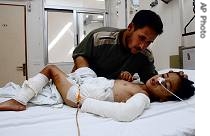2006年VOA标准英语-Israeli-Dropped Cluster Bomblets Threaten South(在线收听)
By Margaret Besheer
Beirut
27 August 2006
 Lebanese Sobhi Abbas, top, comforts his son Abbas Abbas, 6-years-old, who was injured while playing with a cluster bomb in Blida, on Saturday August 26, 2006 |
||
-----
As soon as the truce went into effect on the morning of August 14, displaced Lebanese packed up their belongings and left the many schools and public parks where they had been sheltering while the south was under siege.
In several cases, they returned to villages that were completely destroyed during Israeli air strikes and shellings intended to incapacitate Hezbollah's ability to fire rockets into northern Israel.
Although the guns are now quiet, returning residents face a new threat; this one from unexploded munitions, particularly cluster bomblets.
During the last two weeks of calm, Lebanese government figures show 12 people have been killed from cluster bomblets, including two children, and 45 other people have been injured.
This past week, the U.S. State Department said it is investigating whether Israel inappropriately used the U.S.-made munitions in populated areas, in violation of agreements with the United States that restrict where they can be used.
Andy Gleeson, the program manager in Lebanon for the British-based de-mining organization, the Mine Advisory Group, explains what a cluster bomblet is:
"It is a sub-item of an overall munition," he said. "For instance, a rocket or shell or projectile would contain a series of bomblets within it and these are cluster submunitions."
On the day of the ceasefire, the U.N.'s Humanitarian Coordinator in Lebanon, David Shearer, warned residents returning to the south about the possibility of unexploded cluster bomblets.
"It has been estimated that around 10 percent of the shells fired from Israel into the south of Lebanon may not have not gone off. And this is obviously going to be very dangerous," said Shearer. "In addition to this we have had reports of cluster munitions being used, particularly around Nabatiyeh, and they are scattered all over the road."
Dalya Farran, the spokeswoman for the U.N. Mine Action Coordination Center based in the southern city of Tyre, says so far, U.N. teams have found 380 locations that are contaminated by cluster bomblets and that number is rising daily.
"We know that now we have a huge problem with cluster bombs. We are really concerned about it and it is a big challenge and it is really urgent to deal with it now," said Farran. "On a daily basis we are locating an average of 30 new locations of cluster bomb strikes."
Farran says since August 14, U.N. teams have destroyed about 2,000 cluster bomblets, many of them found in people's gardens, on their balconies and roof tops. Some were also found on a hospital roof.
The bomblets often do not explode on impact, making them a hazard to returning civilians, particularly children, who often mistake them for balls.
The United Nations, and non-governmental groups such as the Mine Advisory Group, are working with the Lebanese Army and the National De-Mining Office to try to raise awareness of this danger and to clear the south for civilians so they can get on with the business of rebuilding their lives.